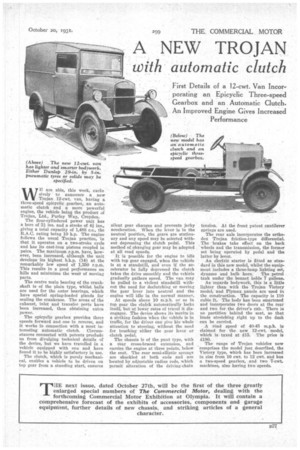A NEW TROJAN
Page 45

If you've noticed an error in this article please click here to report it so we can fix it.
with automatic clutch WE are able, this week, exclu sively to announce a new Trojan 12-cwt. van, having a three-speed epicyclic gearbox, an automatic clutch and a more powerful engine, the vehicle being the product of Trojan, Ltd., Purley Way, Croydon.
The four-cylindered power unit has a bore of 21 ins, and a stroke of 41 ins., giving a total capacity of 1,488 c.c., the R.A.C. rating being 10 h.p. The engine follows the usual Trojan practice, in that it operates on a two-stroke cycle and has its cast-iron pistons coupled in pairs. The maximum r.p.m. have, however, been increased, although the unit develops its highest blip. (14) at the remarkably low speed of 1,350 r.p.m. This results in a good performance on hills and minimizes the wear of moving parts.
The centre main bearing of the crankshaft is of the plain type, whilst balls are used for the outer bearings, which have special spring-loaded glands for sealing the crankcase. The areas of the exhaust, inlet and transfer ports have been increased, thus obtaining extra power.
The epicyclic gearbox provides three speeds forward and one in reverse, and it works in connection with a most interesting automatic clutch. Circumstances connected with patents preclude us from divulging technical details of the device, but we have travelled in a vehicle equipped with one and have found it to be highly satisfactory in use.
The clutch, which is purely mechanical, enables a vehicle to be driven on top gear from a standing start, ensures silent gear changes and prevents jerky acceleration. When the lever is in the neutral position, the gears are stationary and any speed may be selected Without depressing the clutch pedal. This method of changing gear may be adopted at all road speeds.
It is possible for the engine to idle with top gear engaged, when the vehicle is at a standstill, and even if the accelerator be fully depressed the Clutch takes the drive smoothly and the vehicle gradually gathers speed. The van may be pulled to a violent standstill without the need for declutching or moving the gear lever into neutral and the engine will idle in the normal manner.
At speeds above 10 m.p.h. or so in top gear the clutch automatically locks itself, but at lower rates of travel it disengages. The device shows its merits in a striking fashion When the. vehiele is in traffic, for the &ever can give his whole attention to steering, without the need for touchine' either the gear lever or clutch pedal.
The chassis is of the punt type, with a rear cross-braced extension, and carries the engine at three points, below the seat. The rear semi-elliptic springs are shackled at both ends and are located by adjustable radius rods, which permit alteration of the driving-chain tension. At the front patent cantilever springs are used.
The rear axle incorporates the orthodox Trojan friction-type differentiaL The brakes take effect on the back wheels and the transmission the former set being operated by pedal and the latter by lever.
An electric starter is fitted as standard in this new model, whilst the equipment includes a three-lamp lighting set, dynamo and bulb horn. The petrol tank under the bonnet holds 7 gallons.
As regards bodywork, this is a little lighter than with the Trojan Victory model, and Plyrnax -panels are used in the construction. The capacity is 110 cubic ft. The body has been smartened and incorporates two doors at the rear and two for the driver's cab.. There is no partition behind the seat, so that loads stretching right up to the dash can be carried.
A road speed of 40-45 m.p.h. is claimed for the new 12-cwt. model, which is taxed at £15. The price is £180.
The range of Trojan vehicles now comprises the model just described, the Victory type, which has been increased in size from 10 cwt. to 12 cwt. and has a two-speed gearbox, and two .7-cwt. machines, also having two speeds.




































































































